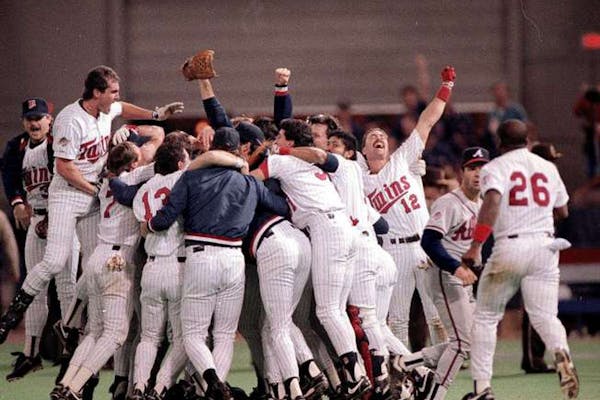 See
more of the story
See
more of the story
There were two outs in the ninth inning, and the Twins were about to fail to hit a home run for a second time in a stretch of 22 games. Then Atlanta reliever Josh Tomlin threw a pitch below the midsection, where Miguel Sano enjoys them, and the big man blasted a three-run homer to left field.
This reduced the Braves' margin of victory Wednesday to 11-7 — and did nothing to change the view that the Twins no longer can afford to send Martin Perez to the mound to start games — but Sano's 20th homer of the season also did this:
Put the 2019 Twins on the precipice of blowing past a record that us original followers of this ballclub never imagined would be challenged.
Stats and more
2019 Twins statistics

We were afflicted with mad fascination with the Twins upon their arrival for the 1961 season, and two years later, when they hit 225 home runs, it was such a story that the national baseball press was wondering if there was something magical with the prevailing winds on the Bloomington prairie.
Harmon Killebrew hit 45 to lead the American League in home runs for the third of what would be six times. Bob Allison hit 35. Rookie Jimmie Hall hit 33, the most in AL history for a hitter who entered his first season without a previous big-league at-bat. Earl Battey still had his legs as a catcher and hit 26. Don Mincher, a part-time player, hit 17.
One season later, in 1964, Tony Oliva joined the fray as a rookie and hit what would be a career-high 32 home runs. Allison also had 32. Harmon again led the league with 49. Mincher jumped up to 23. Hall, hit in the face by California's Bo Belinsky that May, settled for 25.
The 225 in 1963 was followed by 221 in 1964. Four hundred and 46 home runs in two consecutive seasons. Preposterous.
And now this: Sano's home run put the Twins at 224, with 48 games to play. The heroes of our major league infancy — The Killer and Co. — will be wiped from the top line of the Twins record book during the four-game series with Cleveland in a battle for first place in the AL Central that starts Thursday.
Today's hard baseball that flies is a reality. A bat with the same weight but harder shell is a reality. And what are we adding with those elements — 10 feet or fewer?
What are we adding with swing planes and an emphasis on hitting a ball as hard as possible? Way more than 10 feet.
I was listening to Dan Le Batard's radio show Tuesday morning, after Sano's monstrous game-winner the previous night, and they were talking baseball (not a favored topic on Dan's show), talking Twins and asking what in Hades was going on in Minnesota?
And this occurred to me:
This time, do we appreciate what's going on up here on the prairie with a history-shattering power display? When you are so much in the middle of it on a daily basis, do you get so worked up over flawed pitching than what's being done by Nelson Cruz, Max Kepler, Mitch Garver, etc. starts to be taken for granted?
On Wednesday morning, before Perez put the Twins in a rapid-fire hole and Atlanta won two of the three-game series, manager Rocco Baldelli was asked about his level of amazement over this. Usually measured, Baldelli let himself go:
"It has been one of the most amazing offensive performances that we'll ever see. I encourage people to enjoy it, because we don't know if we ever are going to see it again.
"There's all that talk about the baseball, but we also have hitters who are consistently giving themselves the best chance to drive that ball with outstanding at-bats. They are finding pitches to hit and putting the barrel on those with powerful swings.
"We thought we had the ability to be a good offensive group leaving spring training. I don't think we thought we would have a leadoff hitter [Kepler] with 31 home runs Aug. 7.
"This isn't a streak. It has been going on all year long. And, remember, when the season started, it was ice cold. We played the coldest schedule in baseball for the opening weeks. So cold you couldn't feel your hands, and still we had hitters taking outstanding at-bats and driving the ball.
"This is special. It is an experience to be part of it."
It was mentioned to Baldelli that a story line offered in 1965, when exit velocity was how fast a team could pack up in the clubhouse to catch a commercial flight, was that the Twins hitting fewer home runs (150) was a positive — that they had stopped waiting for homers, moved runners in other ways, and thus went to the World Series.
"This is good baseball, too," Baldelli said. "Winning is good baseball. Scoring runs is good baseball."






